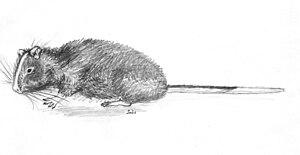Machu Picchu Inca rat
| Machu Picchu Inca rat | ||||||||||||
|---|---|---|---|---|---|---|---|---|---|---|---|---|

Machu Picchu Inca Rat ( Cuscomys oblativus ) |
||||||||||||
| Systematics | ||||||||||||
|
||||||||||||
| Scientific name | ||||||||||||
| Cuscomys oblativus | ||||||||||||
| ( Eaton , 1916) |
The Machu Picchu Inca rat ( Cuscomys oblativus ) is a barely researched rodent species from the chinchilla rat family (Abrocomidae). It is known as the Lazarus taxon because, between its first description in 1916 and its rediscovery in 2009, it was only known from two 15th-century skulls that were discovered in 1912 during excavations in Inca tombs at Machu Picchu .
features
Based on the only existing skeletal material (two skulls), the greatest skull length of the Machu Picchu Inca rat is 63.6 to 63.7 mm. Further measurements are not known. The skull of the Machu Picchu Inca rat has a round large occipital hole and a smaller tympanic sac than the closely related Ashaninka Inca rat ( Cuscomys ashaninka ), which was only described in 1999. The posterior nasal bone is separated from the frontal bone by an insertion. The bridge of the nose is slightly curved. The third upper molar has wide posterior, lateral comb-like melting strips (transverse yokes) that are connected to the cusps of the teeth.
The specimen that was caught in 2009 was probably an adolescent animal, as the adult fur was still incomplete. Outwardly, it was similar to the Ashaninka Inca rat, but it had lighter ears that were more tapered at the tips. The fur on the back was brown and covered with long, black upper hair. The back and front of the head were speckled with long, white hair. The white forehead stripe was narrower on the muzzle. The hind and front paws were pure white. The tip of the tail was snow-white.
habitat
The Machu Picchu Inca rat lives in damp cloud forests on steep rocky slopes at altitudes of around 2,700 m on the Machu Picchu ridge.
Way of life
The Machu Picchu Inca rat that was caught in 2009 was feeding on leaves and herbs in a clearing near the Wiñay Wayna Inca ruins . It held the leaves with its front paws while it ate. No more is known about their way of life.
Systematics and nomenclature
The Machu Picchu Inca rat was described in 1916 by the American paleontologist George Francis Eaton (1872-1949), a companion of Hiram Bingham , as Abrocoma oblativa . In 1999 Louise H. Emmons created the new genus Cuscomys and classified Cuscomys oblativus as a type species. Often one finds the spelling Cuscomys oblativa according to the type epithet in the first description. However, since Emmons declared the genus name to be male in terms of nomenclature , oblativus would be the correct spelling according to the International Rules for Zoological Nomenclature .
status
The Machu Picchu Inca rat was in 2008 by the IUCN in the category "extinct" ( extinct ) of the Red List added. In 2016 this classification was changed to “insufficient data” ( data deficient ). In 2009, the park ranger Roberto Quispe caught an injured animal about 5 km southeast of Machu Picchu. He took around 40 photos of the specimen and released it after three days near the Inca ruin Wiñay Wayna after it was tended. However, he could not cite the photos as evidence that he had indeed rediscovered the Machu Picchu Inca rat. In 2012, the Mexican biologist Gerardo Ceballos from the Ecological Institute of the National Autonomous University of Mexico and his Peruvian colleague Horacio Zeballos from the Museo de Historia Natural of the Universidad Nacional de San Agustín in Arequipa managed to track down, identify and identify another specimen near Wiñay Wayna thus confirming Quispes Fund.
literature
- George Francis Eaton: The collection of osteological material from Machu Picchu. New Mammals from Machu Picchu. Memoirs of the Connecticut Academy of Arts and Sciences 5, 1916: pp. 87-89
- Louise H. Emmons: Genus Cuscomys Emmons, 1999 In: James L. Patton, Ulyses FJ Pardinas, Guillermo D'Elía (Eds.): Mammals of South America, Volume 2 - Rodents. The University of Chicago Press, Chicago 2015; Pp. 816-818. ISBN 978-0-226-16957-6 .
- Louise H. Emmons: Family Abrocomidae (Chinchilla rats and Inka rats). In: Don Ellis Wilson and Russell A. Mittermeier (Eds.): Handbook of the Mammals of the World. Volume 6: Lagomorphs and Rodents 1 Lynx Edicions, Barcelona 2016, ISBN 978-84-941892-3-4 , p. 495
Web links
- In the shadows of Machu Picchu, scientists find 'extinct' cat-sized mammal
- Spectrum of Science : Lazarus Effect: Mythical Inca Food Rediscovered September 26, 2014.
- Cuscomys oblativa inthe IUCN Red List of Threatened Species 2016.2. Posted by: N. Roach, 2016. Retrieved September 4, 2016.
Individual evidence
- ^ Louise H. Emmons: A New Genus and Species of Abrocomid Rodent from Peru (Rodentia: Abrocomidae) . American Museum Novitates 3279, 1999: p. 1-14.
- ↑ ICZN: Article 30. Gender of genus-group names
